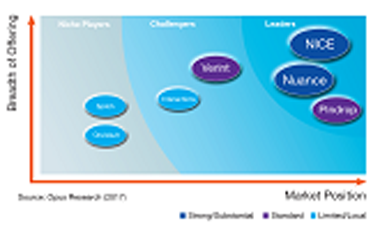The growth of Voice Biometrics, both in terms of number of deployments as well as enrolled voiceprints, has shown steady growth ever since Opus Research’s first global VB Census in 2014 (60 million enrollees) through to 2016 (137 million enrollees), representing annual growth of 84%.
We, at Opus Research, believe that the global voice biometrics industry is poised for an even greater growth rate in the near term, due to a number of positive factors coming together. Most significantly, passive enrollment technologies, which overcome significant friction points in user experience for the caller and the agent alike, are now mature. The alignment with an ever-increasing range of machine-learning capabilities and Big Data analytics has simultaneously yielded immense improvements in fraudster and other watchlist-type identification and defense schemes.
Multiple Technologies are Blending Together
Opus Research's recent Intelliview: Solutions to Optichannel Challenges report evaluates 19 of the top voice biometrics solution providers across Contact Centre Authentication, Contact Centre Fraud and Mobile Authentication domains. NICE's market position among the leaders in both Contact Centre categories comes as no surprise due to its long-standing strength across a wide range of customer experience ('CX'), particularly recording systems (Air & Engage platforms) as well as financial crime, risk, and compliance solutions (Actimize). However, the blending of all of these together with passive voice biometrics into the Real-time Authentication (RTA) product yields an impressive breadth of offering. Proof of this is in the ever-widening range of deployments including Citi Group, Swisscom, Tinkoff Credit Systems Bank and Permata Bank, placing NICE comfortably among the leaders in both contact center categories:
Contact Center Authentication |
Contact Center Fraud Detection |
Delighted Callers are More Likely to Opt-in
Opus Research has long found that contact center security is inextricably linked to improved customer experience. Enterprises are well-advised to make both enrollment and authentication easy. Implementation of passive voice biometrics is having an extremely positive impact on user adoption, due to the seamlessness of the overall contact center processes. While regulations may vary between different countries and regions, the generally accepted best-practice is to obtain informed consent from all enrollees. While organizations work on obtaining such consent, a snow-ball effect is now also becoming evident from some customers who are starting to insist on being enrolled after hearing from colleagues and family who are customers of institutions who have launched voice biometrics.
Multiple-Use Voiceprints Will Catapult Omnichannel Voice Biometrics
In a previous article I wrote about the ability to use passively enrolled voiceprints for active or text-dependent verification. I cited advantages that include the reduction of enrollment friction, including phrase repetition and the collection and management of multiple voiceprints per caller. The ability to use voiceprints that have been created, with user consent, during a natural conversation for future self-service purposes such as IVR and mobile is driving a new wave of opportunities. These are, in turn, attracting more investment and resources, and ultimately greater adoption and utilization across multiple channels.
Next up for passive voice biometrics are 'voice-first' Metabots, such as Amazon Echo, Google Home, Tmall Genie, etc. At the same time, voice biometrics are being integrated into a range of other voice-enabled IoT devices, consumer electronics, appliances and autos. We are rapidly getting to the point where strong authentication, involving at least two unrelated factors, is becoming mandatory. In these cases voice is the most natural due to the speech-interface and audio processing capabilities on these devices.
Voice calls are becoming more important, setting the stage for continued and accelerated growth
As customer service automation continues to drive digital commerce through multiple touchpoints, the purpose of agent-assisted calls is quickly changing to more complex queries, as well treatment of callers who have failed the primary channel authentication – legitimately or otherwise. In these, omnichannel use cases the need for continuous authentication, particularly passive voice biometrics, has elevated importance because it can be used to constantly score the authenticity of a caller in conversation with a live or digital agent. The technologies have proven that security and usability go hand-in-hand. Users have grown more familiar and comfortable with biometrics in general. Government regulators now compel companies to provide stronger protection for consumers and their data. Collectively, these forces are driving mass adoption. We now have our eyes focused on the next generation use of Conversational Commerce in IOT, specifically "VoiceFirst" devices that are poised to become the next wave of digital commerce.



